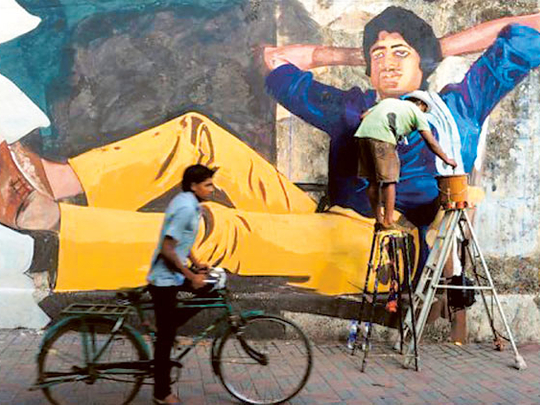
Mumbai: Frustrated by the lack of old Bollywood glamour on the streets of Mumbai, two film buffs are trying to brighten up India’s movie capital with mural tributes ahead of the industry’s 100th birthday.
The iconic image of a reclining, cigarette-smoking young Amitabh Bachchan, the biggest star of Hindi cinema, has been lovingly recreated on a roadside wall, replicating the dying style of hand-painted poster art.
Bachchan’s character Vijay joined the underworld of the city’s mean streets in the 1975 hit Deewaar (The Wall), but the film’s antihero now has pride of place on a lane in the hip Bandra suburb, home to many film stars.
Despite the abundance of slick new posters plastered around Mumbai, artist Ranjit Dahiya says he was struck at how the city’s rich film heritage was being forgotten in recent years.
“I couldn’t see any Bollywood in Bombay, yet this is the city of Bollywood,” Dahiya told AFP, using the city’s old name. “So I thought I should paint the walls on the street.”
The mural in Bandra is the second to be completed as part of the Bollywood Art Project (BAP), a self-funded venture set up by Dahiya and his friend Tony Peter to create film artwork “accessible for everyone”.
The duo hope to finish about one painting a month in the run-up to May next year, when India will celebrate a century since its first silent feature film Raja Harishchandra opened in Mumbai in 1913.
Getting permission is not always straightforward, with plans for a 70-foot (21-metre) dancing girl thwarted by unimpressed locals.
“It depends on the people,” said Dahiya. “Some people are sensible and really know about the art.”
- Mumbai studios “lay forgotten” -
====================================
BAP began life in April with a mural of the 1953 classic Anarkali, one of the greatest hits of its decade, which told the tale of an ill-fated love affair between a beautiful court dancer and a Mughal prince.
“With Bollywood having run for 100 years, the films have run into the hundred thousands at least. We’re skimming over the surface,” said Peter, who runs a film and design company.
Their murals also pay tribute to Bollywood’s old poster painters, whose art Dahiya laments “is going to die” as digital media technology takes over.
It is one of many aspects of the prolific film industry that some fans would like to see preserved in Mumbai, whose role at the heart of the movie world may have passed its glory days.
“There was a time when ‘Bombay’ and ‘Bollywood’ were synonymous,” said a Hindustan Times article this month, wistfully recalling the days when more film premieres were held in Mumbai and star-struck fans thronged film studio gates.
“Since Bollywood has gone global and premieres have shifted to Dubai and Singapore, the city’s studios lay forgotten.”
Much of the studio action now happens in a “Film City” complex in north Mumbai, and film historian Amrit Gangar said that old heritage gems such as the once-famed Bombay Talkies studio had been left to crumble in recent decades.
He lamented India’s attitude to its film heritage and history - from the studios to original film frames to hand-painted billboards - saying that it was crucial for future generations to have reference material from the past.
“At this point of time, not much has been left with us,” he told AFP. “But whatever we could salvage has to be preserved with a lot of care and respect and made public.”
- “Being in Bollywood”-
=========================
Next year’s anniversary could provide a crucial impetus, with other projects springing up across the city in the countdown.
A recent exhibition at the National Gallery of Modern Art explored the relationship between Mumbai and the movies, while the first part of a museum dedicated to Indian cinema is due to open in December.
“It’s going to be pretty huge,” said D.P. Reddy, joint secretary of India’s information and broadcasting ministry, telling AFP that 1.2 billion rupees (20 million dollars) would be spent on the project.
He also listed plans for various festivals, exhibitions and other events to mark the centenary of not just Hindi-language Bollywood, but all Indian cinema.
In March, the UTV Stars television channel launched a “Walk of Fame” in the style of the famous boulevard in Los Angeles, but Mumbai still has some catching up to do to match the legendary landmarks of the US film capital.
“Hollywood is a location but Bollywood is just an entity without a specific location,” said Peter, who hopes to attract more funding to keep their project alive.
“Maybe if our paintings help to create the feeling of being in Bollywood, that will be something we have achieved.”












